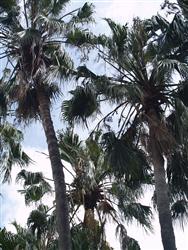Become a Palm and Cycad Expert!
Palms are a very important group of plants, primarily throughout the
tropics. There are palms
growing successfully in cooler places throughout the world, including
Tasmania, England, Canada and Cape Cod in the USA. Many palms however
are not particularly hardy to the cold, and will be injured by
temperatures approaching freezing point. In temperate climates, palms
are also often grown as indoor plants.
- Learn to distinguish between the characteristics of different types
of palms and cycads
- Learn the general cultural practices required to grow palms and cycads
- Learn to propagate, treat pest and disease, manage water and nutrition and more
- Discover how to choose palms and cycads to suit almost any climatic situation
- Learn to use them in the landscape and other commercial applications

COURSE STRUCTURE
There are eight lessons in this course as follows:
1.  Introduction
Introduction
- Scope and Nature of Palm Culture
- Plant Naming
- Species, Cultivars, Varieties
- Characteristics of Palm and Cycad Families
- Botanical Characteristics
- Review of Australian Cycad Genera
- Australian Palm Genera
- Review of Palms
- Sub families, tribes and genera of palms\
- Resources
2. Culture
- Cultivating Cycads
- Understanding Soils, Nutrition, pH, etc
- Soil Mixes for Palms and Cycads
- Mulches
- Fertilisers
- Drainage
- Planting
- Water Management
- Pruning Palms and Cycads
3. Propagation
- Overview
- Propagating Palms from Seed
- Propagating Media
- Other Propagation Methods (for some palms); eg. Offshoots, layering)
- Transplanting Seedlings
- Cycad Propagation; seed, offsets, suckers
- Transplanting cycads
- Managing pest and disease
- Propagating Equipment
4. Selecting Suitable Palms and Cycads
- Growth Habits; solitary, clumping, aerial branching, subterranean branching, climbing
 leaf Types; palmate, pinnate, bipinnate, fan
leaf Types; palmate, pinnate, bipinnate, fan- Review of palm genera
- Cycad genera
- Cold tolerant palms and cycads
5. Pests & Diseases of Palms and Cycads
- Scope and Nature of Pest Management
- Use of Chemical Legislation
- Common palm and cycad pests
- Common palm and cycad diseases
6. Using Palms and Cycads
- Growing palms in a greenhouse
- What palms can be grown in a greenhouse or conservatory
- Environmental management and plant needs
- Temperature, Ventilation, Light Management
- Landscaping with Palms
- How palms can be used for different affects
- Planting Design
- Preparing a Plan
7. Commercial Applications For Palms & Cycads
- Scope and Nature of Uses for Palms
- Rattan
- Palm Oil
- Dates
- Coconut
- Coir Fibre
- Palms as Indoor Plants
- Species Suited to Indoor Plant Culture
8. Special Assignment
A PBL assignment where you deepen your knowledge by planning the
establishment of a collection of different cultivars of palms or cycads
(your choice) that are suited to growing in a particular situation or
locality.
Learn all About Palms (& Cycads)
At first glance all palms might look the same; a closer look however will highlight significant differences between one variety and the next. Trunks can be smooth, ridged or even prickly, with the dead bases of old fronds either clinging to the trunk or completely removed. Fronds can be large of small, fan shaped or feather like (deeply divided like a fern leaf).
Foliage and trunk colour can vary also, and though most palms have mainly green foliage with shades of green, brown or grey in the trunk, there are species with shades of red, yellow, white and other colours.
The large fan or feather-like fronds can provide an excellent contrast to smaller leaved plants. As they grow, their shade gives a dappled effect to understorey plants, providing an excellent growing environment.
The trunks may be a main feature or they can be used as a host support for epiphytic plants such as orchids, ferns (elkhorns and staghorns) and climbing philodendrons.
With such a huge range available, anyone can create that wonderful, tropical, relaxing effect, of swaying palms and rustling foliage, as the wind gently blows through the fronds.
Most palms, except the drier inland species, require moist soil conditions with good drainage. The soil should not be allowed to dry out totally. Palms, especially those from rainforests, can handle the occasional short waterlogged period. The soil is best if slightly acid – pH 6.0 to 6.5 – though palms can handle a wide range of soils from clay to sand.
Being hungry feeders, compost enriched soil or fertilizers may be needed. High nitrogen fertilizers with an N-P-K ratio of 10-3-6 are regarded as the best and should be applied in spring, summer and early autumn at a rate of about 3 to 5 kg per square metre.
If older fronds become yellow, this indicates a nitrogen deficiency which can be corrected with fertilizers such as sulphate of ammonia. Dead fronds are frequently removed to keep palms looking tidy and to prevent them dropping onto people, cars and so on. If fronds are cut back while still green though, this can set the plants back and slow growth. Because their trunks are so flexible and bend in the wind, tall palms are less likely to blow over in a strong wind than a similar size woody tree.